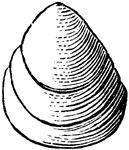Clipart tagged: ‘lingula’
Lingula anatina
"The Lingula anatina has a long peduncle issuing from between the umbones. The valves are nearly…
Lingula
The Lingula have tongue-shaped shells with a long fleshy stalk, or pedicle, with which the animal burrows…

Lingula Antigua
The Lingula antigua is a little bivalve shell belonging at the bottom of the class Brachiopoda. The…

Lingula Prima
The Lingula prima is a little bivalve shell belonging at the bottom of the class Brachiopoda. The inarticulate…